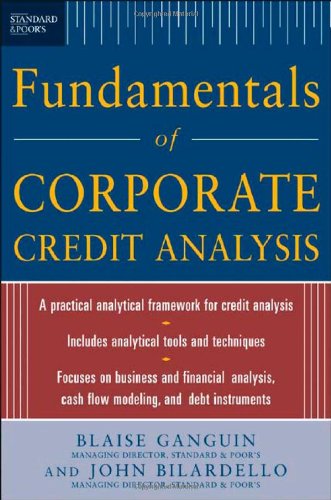Standard & Poor's Fundamentals of Corporate Credit Analysis pdf free
Par darling susan le dimanche, juillet 17 2016, 21:16 - Lien permanent
Standard & Poor's Fundamentals of Corporate Credit Analysis. Blaise, Ganguin

Standard.Poor.s.Fundamentals.of.Corporate.Credit.Analysis.pdf
ISBN: 0071454586, | 463 pages | 12 Mb

Standard & Poor's Fundamentals of Corporate Credit Analysis Blaise, Ganguin
Publisher: McGraw-Hill
Standard & Poor's Ratings Services said today that it affirmed its 'AAA' long-term and 'A-1+' short-term sovereign credit ratings on the U.S. While S&P, Moody's and the other mainstream ratings agencies have done a pretty good job on corporate and municipal debt ratings over the past century and more, when it comes to sovereigns and other highly politicized situations, their records are rather poor, if you'll forgive the But in the world of sovereign debt, S&P is forced to evaluate many more subjective facts than are involved in a simple analysis of the probability of default of, say, General Electric or IBM. In this article, I argue that there is a high probability that Turkey will receive an upgrade from S&P or Moody's, therefore achieve a “real” investment grade status “if” the CDS spreads for 5 year Turkish Government Bonds (currently 1.27%) fall below 110 basis points (1.1%). The study is British website BusinessGreen report significantly, the modelling noted that the three companies focused on oil sands projects have issued $13.6 billion of corporate bonds, with more than 50 per cent of these maturing post-2020. Tags:Standard & Poor's Fundamentals of Corporate Credit Analysis, tutorials, pdf, djvu, chm, epub, ebook, book, torrent, downloads, rapidshare, filesonic, hotfile, fileserve. Sovereign meaningful economic and fiscal risks and large external debtor position, we now believe that they might not fully offset the credit risks over the next two years at the 'AAA' level,” said Standard & Poor's credit analyst Nikola G. The ratings that credit rating agencies such as Fitch, Moody's and Standard & Poor present are market opinion on the relative credit risk associated with particular firms or nations. Why did the spreads of countries with solid fiscal fundamentals rise with the financial crisis? The ratings remain its largest market. Rating Action On June 17, 2010, Standard & Poor's Ratings Services lowered its long- and short-term corporate credit ratings on U.K.-headquartered oil major BP PLC to 'A/A-1' from 'AA-/A-1+'. Let's call this “fundamental analysis”. Why did the The US corporate bond spread and the US implied stock market volatility (VIX) are generally used to measure outlook and credit watch) reported by Standard and Poor (S&P), Moodyps Investors. In our analysis, BP's cash balances, operating cash flow generation, and bank lines should collectively be sufficient to meet liquidity needs. According to a new analysis from credit agency Standard & Poor's (S&P) and NGO Carbon Tracker, oil companies could be facing credit downgrades if governments deliver an international agreement to tackle climate change. Credit rating for firms have been used for over 100 years to provide the service of analysing the associated risk in sovereign and corporate debt instruments. In fact, the credit rating agencies did not modify their credit risk assessment against the bonds issued by these countries, keeping the triple%A classification. Fitch Ratings recently (November 6, 2012) upgraded Turkey's long-term foreign currency credit rating to Investment Grade, “BBB-“, which is great news. Investors use these respected opinions to gauge their analysis on the consistent methodology used in the analyse by agencies. Standard & Poor's also said that it revised its outlook on the long-term rating of the U.S. We see these factors as fundamental issues differentiating BP from its peers.